Transcend AVE3 VIA Apollo 133A
Motherboard Review
Transcend's position is a very unique one indeed.
Now a full scale manufacturer of a wide range of motherboards and memory
modules, Transcend can be considered the "one and only" in the industry to
specialize in both areas. Covered here is our first Transcend review in which we
take a look at their VIA Apollo Pro 133A based solution, the AVE3.
The
market is literally flooded by the overwhelming number of Apollo Pro 133A based
motherboards. Iwill, for example, took a different approach by implementing IDE
RAID on their VD133Pro mainboard. However, Transcend decided to take a rather
"brute force" approach in pushing their AP133A offering. You will see later in
this review why the AVE3 impressed us here and also why is just nearly missed
receiving our Editor's Choice award.
So then what exactly sets the AVE3
apart from the others? Read on to find out...
Specifications
- Socket 370
interface which supports Intel Celeron / Celeron II / FC-PGA Pentium III CPUs /
Cyrix III CPU.
- Based upon the VIA Apollo Pro 133A chipset (694x/686A)
-
Support for Virtual Channel Memory (VCM)
- 3 x 168-pin DIMM slots for a
maximum of 1.5GB of system memory
- 1 ISA / 5 PCI / 1 AGP / 1 AMR (shared
with 1 ISA slot)
- Dual ATA/66 HDD headers
- Support for 66 - 150MHz FSB
speeds (through BIOS and jumpers)
- 4 x USB Ports
- On-board AC97 audio
CODEC
- Hardware Monitoring Support
- Award V6.00 BIOS
- ATX Form
Factor, 4-layer PCB. 19cm x 30.5cm
What's
Included
Along with the AVE3 motherboard comes a 52-page manual.
Though not as long as manuals found with those Asus boards, this one
is quite helpful and specific in order to get the user's job done.
And frankly, I would not like to see it any other way. In addition to
the 2 USB ports already located in the ATX I/O headers, Transcend has included 2 additional
ports which come along and take residence occupying a cabinet
slot.
The usual floppy, HDD cables and driver CD are included as well. An
additional bonus that we would like to see as a trend is the inclusion of the
thermal sensor. Of all the boards tested, only Soltek and Transcend have
included these sensors with their motherboards.
It is certainly pleasing to see
mainboard manufacturers starting to pay more attention to the layout of their
products. With the AVE3, it was rather difficult to find any fault with anything
at all. Clean layout and design permits me to think that Transcend spent extra
time the planning stage of the AVE3. First of all, it is a well known fact that
ISA cards are on their way out of existance and AMR devices have not seen much
daylight at all. The 1 ISA and 1 AMR slot present on the AVE3 are shared. This
means that you can only use one of the devices at a given time as each slot
occupies the same cabinet position. It was certainly pleasing to note Transcend
did take the more practical aspect of the situation.

Positioning and placement of the on board audio inputs are thoughtfully
located in between PCI slots as to avoid any interference between the audio
cables and PCI hardware. The only oddity that I might find with this is the
event of having two neighboring card attached via a pass through connector.
Other than that, the board design is absolutely flawless.
As with other
ATX boards out there, installing the AVE3 was no sweat. Depending upon the CPU
you wish to install on this board, you must first verify whether the FSB jumper
is configured correctly. With these particular jumpers, you must set either a
66, 100 or 133MHz FSB which is strictly based upon the "official" speed of your
CPU. Celeron users must set the jumpers at 66MHz, Pentium III and III E owners
should opt for a 100MHz bus and Pentium III EB users will use the 133MHz
setting.
The sample I received included VIA 4-in-1 drivers V4.20,
however, version 4.22 was used in all testing.
Test Bed
setup
To put the Transcend AVE3 through its trial runs, we used to the
following hardware...
- Celeron 400 CPU
- 128MB PC100 SDRAM
- 8.4GB
Quantum CR Hard disk
- Windows 98 (standard)
We also used the
following motherboards in this review for comparative purposes...
- Iwill
VD133Pro Motherboard
- Soltek 67KV Motherboard
- Asus P3B-F
Motherboard

